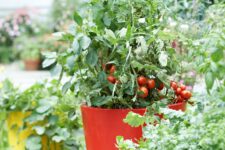
10 Essential Tips for Growing Tomatoes in Pots
Growing tomatoes in pots is easy if you have a spot that receives lots of sunlight, perhaps on your deck, patio, or balcony. You can raise all your favorite kinds of tomatoes in containers, from deep red slicers to tiny grape tomatoes. It just takes a little more work than garden-planted tomatoes because of the limited access to water and nutrients. Give your potted tomato plants some extra care, and they’ll richly reward you with handfuls of sun-ripened fruit. These 10 tips will help you successfully grow your tomato plants in pots.
1. Plant a patio or bush tomato variety.
Small tomato plants, known as patio or bush varieties, grow and fruit best in containers. Don’t be fooled by the size of a plant—a small tomato plant can produce loads of fruit. Pot-friendly types of tomatoes typically grow to a particular size, usually 1 to 3 feet tall, and then begin fruiting. There are many patio-type tomato varieties, and dozens more coming onto the market every season. The best tomato varieties for pots include ‘Patio Choice Yellow,’ ‘Tumbler,’ ‘Bush Early Girl,’ ‘Pixie,’ ‘Tiny Tim,’ and ‘Small Fry.’
Tomato plants are either determinate or indeterminate. Patio and bush varieties are determinate, meaning they stop growing at a certain height, which makes them more suitable for growing in pots. Indeterminate types of tomatoes continue growing indefinitely, so they are more challenging to keep in containers or other small spaces.
2. Choose a BIG pot.
Tomatoes have a large, wide root system. The bigger the container, the more room the plant’s roots have to grow. The best choice for growing tomatoes in pots is a container that holds at least 5 gallons of soil and measures 20 inches wide or more. A 5-gallon bucket, although not particularly attractive, makes a fine tomato container after you drill drainage holes in the bottom.
Growing tomatoes in pots can be done in a hanging planter, but they need extra support, such as wall anchors, because the container can weigh over 50 pounds. Choose smaller varieties to plant in hanging planters. When there’s little or no yard area or patio space, such as on an apartment balcony, hanging planters are a great option.
3. Drainage is key.
Tomatoes will grow in plastic, clay, and stone pots, but growing containers that lack drainage holes are useless. Drainage holes allow excess water to escape, which is essential to avoiding root rot and other plant diseases. Only plant tomatoes in pots that have good drainage.
4. Use potting mix.
A pot of regular soil scooped from your garden will not drain fast enough for container plants. Growing tomatoes in pots will be much more successful in a potting mix labeled for container gardening. Lightweight and easy to use, potting mixes are designed to have great drainage while retaining enough moisture to keep plants hydrated.
5. Provide nutrients.
Nutrients fuel a tomato plant’s fast growth. Plus, potting mix drains quickly, taking nutrients with it. For these reasons, you need to fertilize your potted tomato plants regularly.
One of the easiest ways to provide nutrients when growing tomatoes in pots is through a slow-release fertilizer mixed into the potting mix at planting time. Look for a product designed specifically for vegetables. Then, four to six weeks after planting, fertilize the plants again with a slow-release fertilizer mixed into the top 2 inches of soil or use an organic product, such as fish emulsion, greensand, or kelp meal.
6. Give tomato plants plenty of sunlight.
Growing tomatoes in pots requires at least eight hours of sunlight daily for the best growth and fruiting. Ample light is also essential for producing flavorful fruit. Place your potted tomato plants on the south or west side of a building, where they will receive the most direct sunlight.
7. Water tomato plants in pots regularly.
Tomatoes are thirsty plants, especially when they begin to gain size. Add in hot or windy conditions, and you may have to water your potted tomatoes twice a day. Your goal is never to let the potted tomato plants dry out enough to wilt because a wilted plant is a stressed plant, which can affect your harvest. Morning is the best time to water, but if your containers have dried out significantly throughout the day, water again in the late afternoon. Water plants deeply until you see excess moisture running out of the drainage holes.
The best way to tell if you need to water is to use the “finger test.” Stick your finger down a couple of inches into the potting soil, and if it feels dry, add water. If it feels damp, skip watering.
8. Keep leaves dry.
Several common tomato leaf diseases spread when water and soil splash onto the leaves. Minimize disease spread by watering tomato plants at the base; avoid getting the leaves wet as much as possible. If you’re using a hose to water your tomato plants, adjust the pressure so that potting mix isn’t splashed up onto your plant.
9. Give plants space.
Good air circulation helps prevent disease because moving air dries wet foliage quickly, preventing some diseases. Arrange potted plants so that air can freely pass around them. For example, place your tomato plants so their leaves aren’t against walls or touching other plants as much as possible.
10. Provide support for potted tomato plants.
Tomato fruit becomes heavy as it ripens. Even clusters of small grape and cherry tomatoes can bend and break stems. Support your tomato plants by sinking a trellis or stake into the pot at planting time. Weave tomato stems through the trellis or tie them to the stake as they grow. You can also use tomato cages for support, which have the added benefit of keeping some garden critters from eating your ripe crop or pests from infesting your plants.



